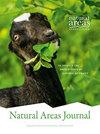Grazing of Reed Canarygrass (Phalaris arundinacea) in Restored Wet Meadows
IF 0.8
4区 环境科学与生态学
Q4 ECOLOGY
引用次数: 0
Abstract
ABSTRACT Reed canarygrass (Phalaris arundinacea) is a grass species that can dominate wet meadow plant communities. This study investigated if grazing by cattle on restored wet meadows suppresses reed canarygrass, thereby promoting the restored plant community. This study was conducted at two locations in northwest Minnesota, one managed by The Nature Conservancy (TNC) and the other a Minnesota Board of Water and Soil Resources (BWSR) wetland bank site. Management practices used were a patch-burn grazing treatment on the TNC site and a high-density, short-duration grazing rotation system on the BWSR site. A pretreatment survey of total species canopy coverage was conducted before grazing followed by periodic surveys up to 7 y after grazing started. Both the patch-burn grazing and the grazing rotation system reduced reed canarygrass canopy cover by 49% compared to non-grazed control sites 5–7 y after grazing. With a reduction in reed canary grass canopy coverage due to grazing, the plant community moved toward a community with higher canopy coverage of Carex pellita that met restoration goals. Some of the species change was to grasses like Kentucky bluegrass (Poa pratensis), which is an exotic, invasive grass in prairies. The changed plant community held steady in native plant species richness or had an increase in native plant species richness. This study demonstrates grazing reduces the cover of reed canarygrass, while meeting restoration goals for wet meadows.芦苇-金丝雀草(Phalaris arundinacea)在恢复湿地的放牧
摘要芦苇鸭草(Phalaris arundinacea)是一种在湿草地植物群落中占主导地位的草本植物。本研究调查了牛在恢复的潮湿草地上放牧是否会抑制芦苇鸭草,从而促进恢复的植物群落。这项研究在明尼苏达州西北部的两个地点进行,一个由自然保护协会(TNC)管理,另一个是明尼苏达州水土资源委员会(BWSR)湿地河岸。所采用的管理做法是在TNC场地进行斑块焚烧放牧处理,在BWSR场地采用高密度、短时间的放牧轮作系统。在放牧前对总物种冠层覆盖率进行预处理调查,然后在放牧开始后7天进行定期调查。与放牧后5-7天的非放牧对照点相比,斑块焚烧放牧和放牧轮作系统都使芦苇-鸭草的冠层覆盖率降低了49%。由于放牧,芦苇-金丝雀草的冠层覆盖率降低,植物群落向一个覆盖率更高的苔草群落转移,达到了恢复目标。一些物种的变化是像肯塔基蓝草(Poa pratensis)这样的草,这是草原上的一种外来入侵草。改变后的植物群落保持本地植物物种丰富度稳定或本地植物物种丰度增加。这项研究表明,放牧减少了芦苇鸭草的覆盖,同时达到了潮湿草地的恢复目标。
本文章由计算机程序翻译,如有差异,请以英文原文为准。
求助全文
约1分钟内获得全文
求助全文
来源期刊

Natural Areas Journal
环境科学-林学
CiteScore
1.70
自引率
11.10%
发文量
50
审稿时长
>36 weeks
期刊介绍:
The Natural Areas Journal is the flagship publication of the Natural Areas Association is the leading voice in natural areas management and preservation.
The Journal features peer-reviewed original research articles on topics such as:
-Applied conservation biology-
Ecological restoration-
Natural areas management-
Ecological assessment and monitoring-
Invasive and exotic species management-
Habitat protection-
Fire ecology.
It also includes writing on conservation issues, forums, topic reviews, editorials, state and federal natural area activities and book reviews. In addition, we publish special issues on various topics.
 求助内容:
求助内容: 应助结果提醒方式:
应助结果提醒方式:


